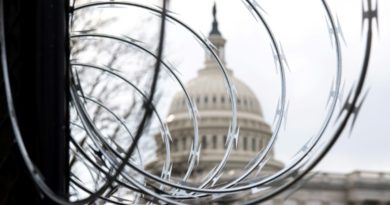OP-ED: Filipino nurses battled discrimination to work in American hospitals. Now they fight for PPE
Justin Foronda, second from left, has dinner with his mother, Lina, left, brother Anthony and Anthony’s girlfriend Michelle Diaz. When the coronavirus crisis began, Foronda, a nurse at Sherman Oaks Hospital, took on extra shifts. About 18% of registered nurses in California are of Philippine descent, according to a 2016 survey. (Gina Ferazzi / Los Angeles Times)
.
.
Column: Filipino nurses battled discrimination to work in American hospitals. Now they fight for PPE
.
‘The 2019 Plague” Day 172’

If you live in Southern California, there’s a good chance that you have at some point received medical care from a Filipino American professional.
Filipino nurses — along with doctors, anesthesiologists and every other kind of medical worker — are an essential source of labor at public hospitals such as L.A. County-USC, Kaiser Permanente and Ronald Reagan UCLA. Filipinos also staff and own many long-term care and mental health facilities.
.

And about 18% of registered nurses in California are of Philippine descent, according to a 2016 survey.
Nursing is such a popular profession among Filipinos that it’s something of an inside joke. My roommate at UCLA used to say that he was going to be the first member of his family to become something other than a nurse.

After working a 12-hour nursing shift at a Sherman Oaks Hospital, Justin Foronda removes his work clothes in the backyard before entering the house as a coronavirus precaution. (Gina Ferazzi / Los Angeles Times)

And when I met HiFi Kitchen chef Justin Foronda earlier this year and asked him what he did for a living, he responded, “I’m a nurse, of course!”
As for my roommate? Today, he is, of course, a nurse.
Foronda has always heard that Filipinos go into the medical field because they are caring, resilient, hardworking and kind. But he’s never been satisfied with that answer.
“We get put into this box, like, oh, it’s funny that all the Filipinos are nurses,” said Foronda, a nurse at Sherman Oaks Hospital.
But the real story of why Filipino nurses came to the U.S. is the “legacy of a very long colonial history between the U.S. and the Philippines,” said Catherine Ceniza Choy, a UC Berkeley professor who wrote about the history of Filipino nurse migration.

Nurse Justin Foronda disinfects his belongings in the backyard of his L.A. home as a precaution against the coronavirus. Foronda is also a chef at HiFi Kitchen, which provides food to hospitals. (Gina Ferazzi / Los Angeles Times)
.

In the 1900s, the U.S. colonial regime began to cultivate a medical labor force in the Philippines. The lofty pretext of imparting Western medicine and civilization had helped politicians to justify the American annexation of the Philippines in 1898, which occurred despite the Philippines declaring independence and installing a democratic government.
When nursing shortages hit the U.S. after World War II, Filipino nurses came to work the jobs that Americans wouldn’t via an exchange program.
More nurses came after the U.S. ended immigration quotas in 1965, as well creating preferential pathways for skilled workers. The effect was further magnified when the Philippine government under Ferdinand Marcos began to actively encourage the export of all kinds of labor as a strategy of economic growth.
Nurses, and other exported workers, were labeled national heroes. And Filipino nurse graduates could not turn down the earning potential of a U.S. job, which was 12 times what they could earn in the Philippines.
Between 1965 and 1988, more than 70,000 foreign nurses came to work in the U.S., with the Philippines as the biggest sender by far.
.

Although American and Philippine nursing schools evolved in parallel and adhered to near-identical professional standards, Filipino nurses were systematically underpaid as exchange visitors and frequently assigned mundane tasks such as emptying bedpans, repairing gowns and janitorial duties.
American opponents of immigrant nurses added additional exam requirements for foreign nurses that failed thousands of Filipino nursing graduates. The exam fee was set at $70, the equivalent of a month and a half’s salary for a nurse in the Philippines. Although the test was a prerequisite for the issuance of a work visa, the test could be taken in few major American cities.
And in 1975, Filipina Narciso and Leonora Perez were charged with the murders of patients at a hospital in Ann Arbor, Mich. A massive deployment of the FBI — involving over 200 employees and more than $1 million — produced a case so weak that even a prosecuting attorney described it as “highly circumstantial.”
.

Cross-examination revealed that a major witness for the prosecution — an alcoholic who admitted to significant memory loss — had no ability to distinguish between Filipinos, Chinese, Japanese and other Asian Americans. During testimony, he also asserted there was a nationwide conspiracy of 1,800 Filipino nurses to assassinate American veterans, and referred to Narciso and Perez as “a couple of slant-eyed bitches.”
Abetted by a prosecution that focused heavily on demonizing Narciso and Perez as foreigners with brown skin, a jury convicted the women of three counts of poisoning.
.

The case became a watershed moment for Filipino Americans.
Filipino nurses around the nation began to recognize a shared experience of racial discrimination and exploitation. Activists reached out to black, Asian and Muslim civil rights groups and formed legal defense funds and nurse support organizations. Eventually, a judge set the verdict aside, citing the prosecution’s “prejudiced” presentation of the case.
I think this history still matters today because hospitals hit with a flood of COVID-19 patients have nurses to care for them in large part because America opened its borders to Filipino nurses.
It matters because Filipino nurses recruited generations of sons, daughters, sisters and brothers to the field, and now entire families are at risk.
It matters because, unlike so many of us who retreated indoors when the pandemic came to Southern California, Foronda took on more shifts at the hospital, unable to sit at home knowing he could help.
.

It matters because Gigi Narisma-Estabillo, 55, is still going to work even though she has to reuse her N95 mask; because in the middle of a pandemic, the hospital laid off half of Narisma-Estabillo’s team, forcing the remaining nurses to care for additional patients and risk further exposure; because Narisma-Estabillo and her fellow nurses still have to beg for personal protective equipment, or PPE, and coronavirus tests; because nearly half of the staff at her hospital is Filipino.
.

The history matters because what it shows is that this country has a responsibility to these workers, and we have not kept up our end of the bargain.
“We think America is great, yet everything that has happened, the fault is from top to bottom. Nothing is working. And we are scared,” Narisma-Estabillo said. “They are pushing us to die.”


SIGN UP TO RECEIVE OUR EMAIL
The most important news of the day about the ASEAN Countries and the world in one email: [email protected]










